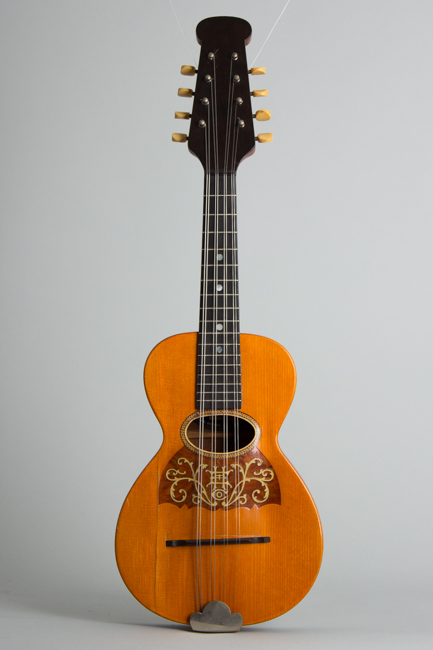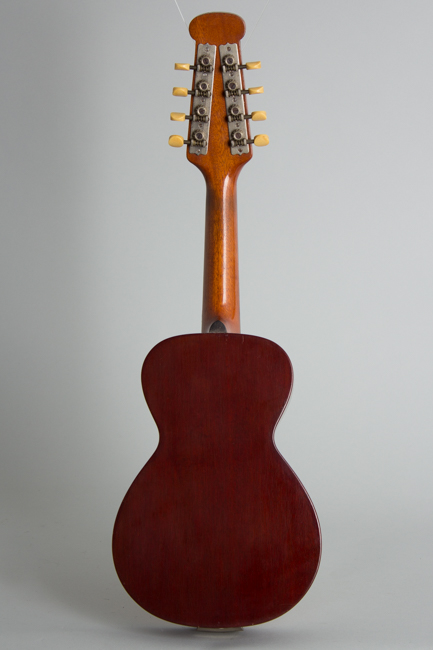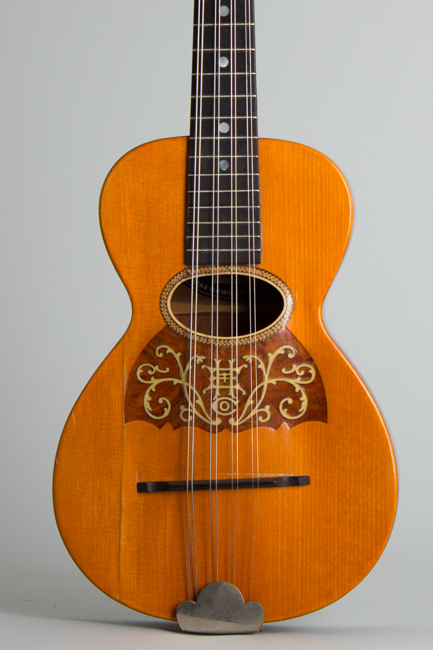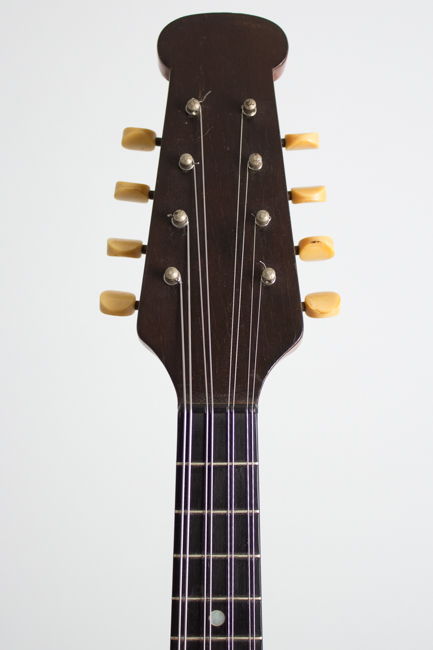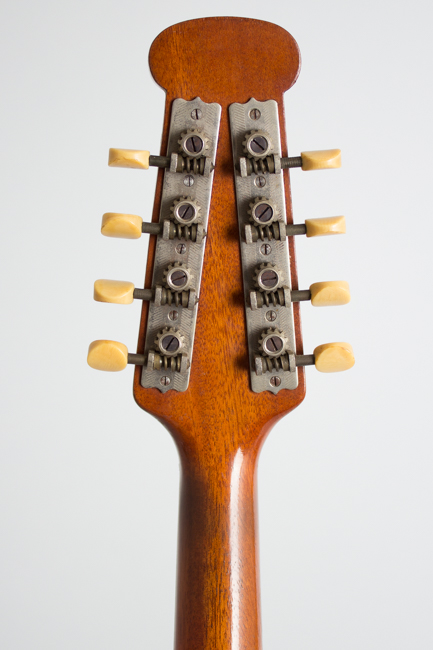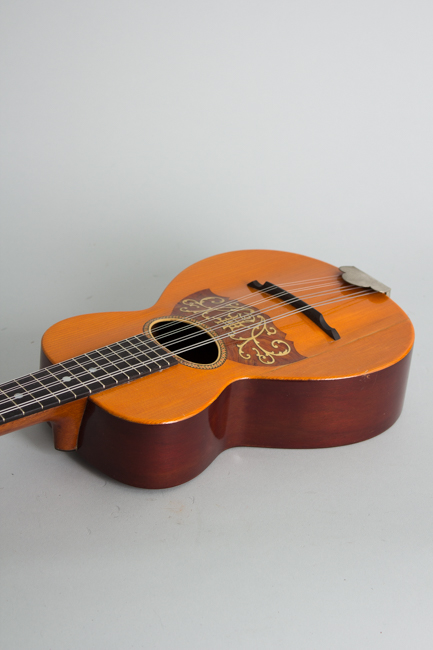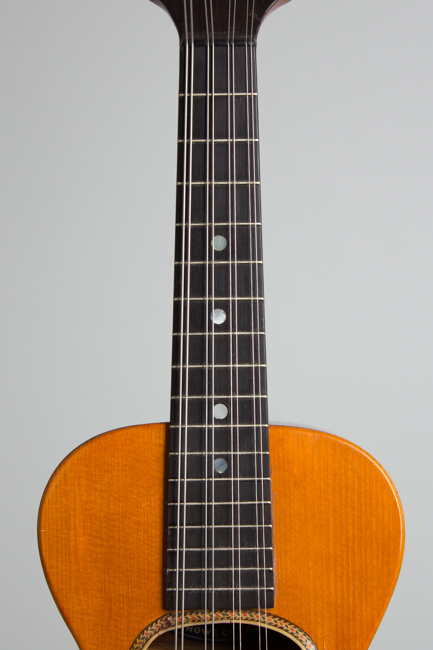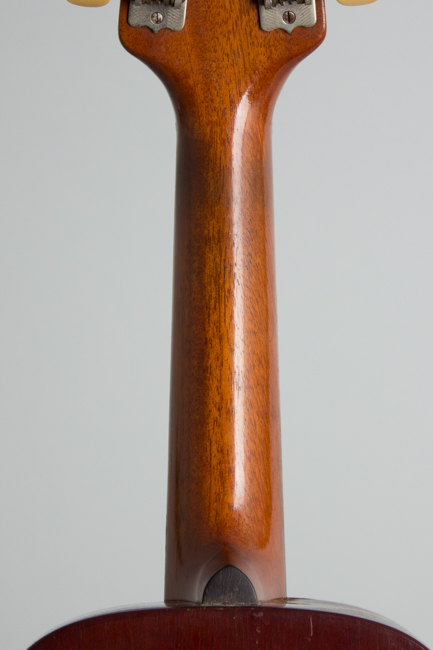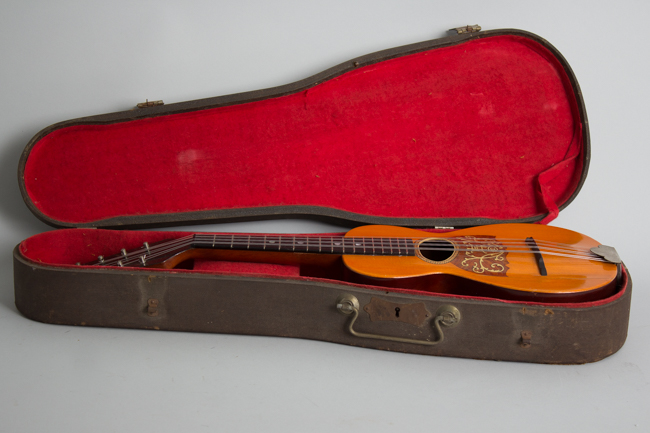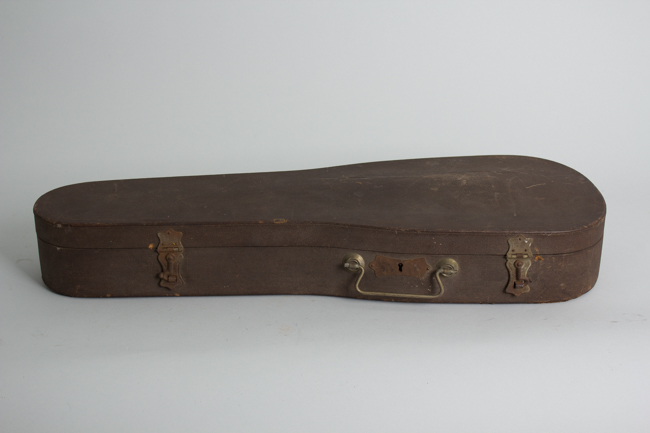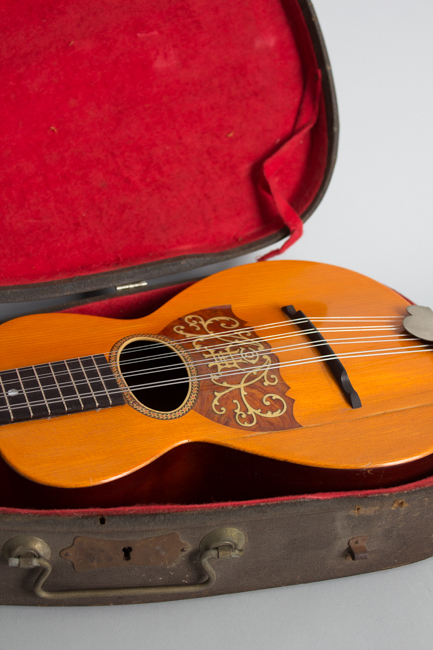Howe-Orme No. 1730 Arch Top Mandolin , c. 1900
This item has been sold.
Item # 10586
Prices subject to change without notice.
Howe-Orme No. 1730 Model Arch Top Mandolin, c. 1900, made in Boston, Mass., natural varnish finish, mahogany back, sides and neck, spruce top, ebony fingerboard, original black hard shell case.
The Howe-Orme instruments of the turn of the last century are rather obscure but quite fascinating, built to a very unique and advanced design compared to the contemporary norms and influential at the time. They were marketed by the Elias Howe company of Boston for a relatively short time from around 1897 until sometime around 1910, when Gibson (who it could be argued poached some of their ideas) came to dominate the mandolin market. The Howe-Orme instruments included several guitars and notably an entire mandolin-styled family including mandolin, tenor mandola, octave mandola, and cello mandola. This series pre-dated Gibson's identical marketing strategy by at least a few years, and was very innovative at the time.
Several patents covering the ideas used on these instruments were granted in the 1890s. The hallmark of all Howe-Orme instruments was described by them as a "raised longitudinal belly ridge"; in simple terms the center section of the spruce top was gently bent upwards and braced in this shape, with a cylindrical arch along the grain line making it stronger in the direction of the string pull. This made it possible for the top to be thinner than a flat design, and much lighter than Gibson's carved top. Vega appropriated this idea in the 1910's (probably as soon as the 14-year patent expired) for their better known Cylinder Back line.
Another distinctive feature of the Howe-Orme mandolins is the tiny guitar-like body with a flat back. Guitar-shaped mandolins were manufactured in some numbers by others in the 1910s, often called "mandolinettos". The Elias Howe Company catalogs claim they built the first such instruments, and tout the ease of handing them in contrast to the awkward Neapolitan bowl-back mandolins typical of the era. The neat fluted headstock is also unusual for the time, prefiguring a number of later designs.
This is a fairly plain but beautifully made mandolin, near the bottom of the Howe-Orme line but still a high quality piece. The back, sides and neck are mahogany with a spruce top and ebony fingerboard and bridge. The neatly inlaid pickguard has a stylized "EH" logo (for Elias Howe) and some filigree design. The 13" scale neck is slim and comfortable; neither the body or neck are bound. A pre-printed label under the soundhole is ink-stamped with the serial number and 1897 patent date. The list price for even this basic model in the early 1900s was $18.75; these were not cheap by any standard. This is a lovely little instrument, outside the main stream of mandolin thought for over a century now but still a delight to play and hear.
Overall length is 22 5/8 in. (57.5 cm.), 7 5/8 in. (19.4 cm.) wide at lower bout, and 1 7/16 in. (3.6 cm.) in depth, measured at side of rim. Scale length is 13 in. (330 mm.). Width of nut is 1 1/16 in. (27 mm.).
This is quite a clean instrument overall, especially for being at least 120 years old! There is one prominent spruce grain split to the top, just above the bridge. This is solidly sealed up but quite visible; "gives it character" they used to say! The finish has only very minor wear overall with typical varnish micro-checking. It appear all original, the floating bridge has been relocated slightly back leaving a mark on the top where it sat for many decades.
There is a small rise in the fingerboard over the body but the instrument still plays quite well, the original tiny frets showing virtually no wear over the century-plus. Strung with light-gauge Thomastic strings this has a lovely sound, with a bowlback character but bright and peppy without sounding at all thin. The original wooden violin-style case is also surprisingly well preserved and functional. Excellent - Condition.
The Howe-Orme instruments of the turn of the last century are rather obscure but quite fascinating, built to a very unique and advanced design compared to the contemporary norms and influential at the time. They were marketed by the Elias Howe company of Boston for a relatively short time from around 1897 until sometime around 1910, when Gibson (who it could be argued poached some of their ideas) came to dominate the mandolin market. The Howe-Orme instruments included several guitars and notably an entire mandolin-styled family including mandolin, tenor mandola, octave mandola, and cello mandola. This series pre-dated Gibson's identical marketing strategy by at least a few years, and was very innovative at the time.
Several patents covering the ideas used on these instruments were granted in the 1890s. The hallmark of all Howe-Orme instruments was described by them as a "raised longitudinal belly ridge"; in simple terms the center section of the spruce top was gently bent upwards and braced in this shape, with a cylindrical arch along the grain line making it stronger in the direction of the string pull. This made it possible for the top to be thinner than a flat design, and much lighter than Gibson's carved top. Vega appropriated this idea in the 1910's (probably as soon as the 14-year patent expired) for their better known Cylinder Back line.
Another distinctive feature of the Howe-Orme mandolins is the tiny guitar-like body with a flat back. Guitar-shaped mandolins were manufactured in some numbers by others in the 1910s, often called "mandolinettos". The Elias Howe Company catalogs claim they built the first such instruments, and tout the ease of handing them in contrast to the awkward Neapolitan bowl-back mandolins typical of the era. The neat fluted headstock is also unusual for the time, prefiguring a number of later designs.
This is a fairly plain but beautifully made mandolin, near the bottom of the Howe-Orme line but still a high quality piece. The back, sides and neck are mahogany with a spruce top and ebony fingerboard and bridge. The neatly inlaid pickguard has a stylized "EH" logo (for Elias Howe) and some filigree design. The 13" scale neck is slim and comfortable; neither the body or neck are bound. A pre-printed label under the soundhole is ink-stamped with the serial number and 1897 patent date. The list price for even this basic model in the early 1900s was $18.75; these were not cheap by any standard. This is a lovely little instrument, outside the main stream of mandolin thought for over a century now but still a delight to play and hear.
Overall length is 22 5/8 in. (57.5 cm.), 7 5/8 in. (19.4 cm.) wide at lower bout, and 1 7/16 in. (3.6 cm.) in depth, measured at side of rim. Scale length is 13 in. (330 mm.). Width of nut is 1 1/16 in. (27 mm.).
This is quite a clean instrument overall, especially for being at least 120 years old! There is one prominent spruce grain split to the top, just above the bridge. This is solidly sealed up but quite visible; "gives it character" they used to say! The finish has only very minor wear overall with typical varnish micro-checking. It appear all original, the floating bridge has been relocated slightly back leaving a mark on the top where it sat for many decades.
There is a small rise in the fingerboard over the body but the instrument still plays quite well, the original tiny frets showing virtually no wear over the century-plus. Strung with light-gauge Thomastic strings this has a lovely sound, with a bowlback character but bright and peppy without sounding at all thin. The original wooden violin-style case is also surprisingly well preserved and functional. Excellent - Condition.
